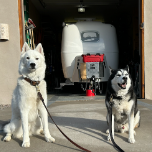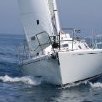
Jim and Chris Neuman
Members-
Posts
177 -
Joined
-
Last visited
My Info
-
Gender or Couple
Couple
My RV or Travel Trailer
-
Do you own an Oliver Travel Trailer, other travel trailer or none?
I own an Oliver Travel Trailer
-
Hull #
770
-
Year
2021
-
Make
Oliver
-
Model
Legacy Elite II
-
Floor Plan
Standard Floor Plan
-
What model is your other RV or Travel Trailer?
Jason 35 cruising sailboat
Recent Profile Visitors
3,277 profile views
Jim and Chris Neuman's Achievements
-
Lots of good info above. I will add that in recent years summer wildfires are increasingly common in the western US and Canada and this is doubly true in the forested portions of Idaho. particularly in late summer. If you are planning on traveling the west in summer you can typically kiss your campfires goodby as things dry out. Smoke can get pretty nasty at times so prepare for that. I have packed N95's for years and have been glad I have them.
-
Any marine supply store will have them. Try West Marine. Another thought - if pin detent ball is frozen, then the pin could conceivably back out. Make sure the plunger and detent ball are lubed and move freely.
-
What exterior caulk is the factory using now?
Jim and Chris Neuman replied to Townesw's topic in Mechanical & Technical Tips
Having been in the sealants business for years I would like to share one thought. I have seen many instances where adhesive removers were used to clean up old adhesive and caulks. This is fine so long as the adhesive remover is completely removed or neutralized. The methods to do this are product specific and I won't attempt to go into them here as there are many new products on the market since my retirement from the adhesive and sealants industry. An adhesive remover is not bright enough to know when its job is done and will attack new sealant or adhesive just as happily as the old. This can be both a mess and terribly dexpensive ... to the point where I have seen folks bankrupt their businesses unwittingly through the use of adhesive removers. The butyl caulk / tape holding the window frame to the hull is your primary moisture barrier. The externally applied silicone caulk is secondary and is there primarily to keep dirt out of the joint and improve cosmetics. If you must use adhesive removers do so carefully using only as much as is absolutely necessary. If you soak an existing adhesive joint excess adhesive remover residue is likely still down there doing its job. -
Just a nudge in case other Oliver owners are hesitating on the desirability of upgrading from the twin 3500# Dexter axle / springs issue which has been bringing Oliver owners such joy of late. I have been considering this upgrade since the forum started following the Dexter leaf spring issue. Less than a week ago I was talking this over with my wife Chris on the way into Walrup Lake, a beautiful, remote Forest Service Campground in the WA Cascades. The beginning of a three week vacation found us 36 miles and a couple days of wonderful day hiking into our first destination on this trip when I noticed the rear streetside spring had disassembled itself and had assumed another, non-optimal position. I should have listened to myself earlier. A long day, a $1770 tow and a shortened vacation later I have ordered a set of heavier Alcan springs with hopes to quickly replace the broken spring and also plan on changing out to heavier 5200# axels later this coming March in Grand Junction, CO, home of Alcan Spring. We have around 40K miles on our Oliver and have been generally pleased with the rig. The Dexter axles / springs are another story. Hot bearings led us to change out the cheap Dexter bearings for Timkens at around 5K and now a broken spring has left me less than impressed with the Dexter product and perhaps the thinking that led Oliver into using then on an otherwise top notch trailer.
-
Beautiful Areas on a 6 week Journey!
Jim and Chris Neuman replied to gatorewc's topic in Campgrounds & Parks
Crater Lake and Yosemite also! Nice trip. Were the California Condors hanging in the trees above the Pinnacles NP campground? Keep an eye on the big tree on the ridgeline above the campground - its the one with the green below it from all the Condor poop. They often hang out there. We got treated to a show put on by nine of them a couple of years ago. Kind of makes you hopeful when you consider they were near extinction just a few short decades ago. -
The Legacy II is a two-person rig which is realistically limited to one child sized visitor. There is good and bad news there. Bad news is that you really cannot realistically sleep more than 2 adults comfortably. Good news is that you really cannot realistically be expected to sleep more than two adults comfortably.
-
Replace touch-enabled LED lights with what?
Jim and Chris Neuman replied to Gliddenwoods's topic in Ollie Modifications
You can drill out the rivets easily - had to replace one of ours also. I would stay with a drill bit that is no larger than the rivet used, in my case 1/8". I then used a very short # 8 stainless panhead machine screw sized just long enough to hold the fixture and get through the inner hull but short enough to not pierce or distort the inner cabinet liner. Use an appropriate tap for the thread you chose. If you then need to pull the fixture at some point in the future you will not have to drill it out again - just back out the fastener and use it to install the new fixture. If you feel you have to use another pop rivet you can do that so long as the drill bit you used to remove the old rivet does not enlarge the hole. -
Sea Biscuit Oliver rear basket!
Jim and Chris Neuman replied to rich.dev's topic in Ollie Modifications
I put on one of their tall front storage boxes using their mounting plate. Very impressed with quality and design. Fast shipping fast, easy installation. Good folks to deal with! -
Ran into problems with aluminum pop rivets often when I built and worked on boats. Aluminum rivets are very much subject to corrosion, particularly if used with a dissimilar metal (say stainless or bronze) or in the presence of moisture. Aluminum rivets are just plain weak, particularly around the heads. Stainless pop rivets are much stronger than aluminum and would be my choice, especially if unable to get any type of backer onto the rivet. Stainless 3/16" pop rivets do require some significant body strength to install unless you have a power rivet tool so invite your uncle Guido over for the install. If sticking with standard hollow rivets is your choice than adding quite a few more rivets around the perimeter will spread the load. If you can upgrade a smaller rivet to a larger one, say 5/32" to 3/16", this will give you a stronger fastener and help clean up any fractured glass/resin around the rivet hole as it will increase the surface area available to support the new fastener. I don't think the aluminum rivets would be cut or abraided at all by the glass in a layup ... particularly a chopper gun hull as used by Oliver as the percentage of glass to resin is very low and the glass strands are not oriented.
-
I went with the air bag / Bilstein 5100 combo and have been very happy with the outcome. The Air Lift bags I had installed can be pumped up to 100 PSI but I have found that 30# does the job real well without excessive rear end lift. I did use the Bilstein 5100 ride adjustable front shocks set at 1.75" in order to counteract the nose-down effect you get when pumping up the rear air bags. This combo gives a smooth, level ride and virtually eliminates the hobby horsing you get on uneven road surfaces such as northern frost heaves or slumping road surfaces. Far superior to the factory F150 shocks that came on my '21 crew cab.
-
The Upper Steens Mountain roads are inaccessable until the snows melt - usually mid June or later. Depends on the snowpack and weather. Still the area surrounding the Steens has a ton of stuff to do including amazing birding on the Malheur Refuge. Wild horses can be found surrounding the Steens and great fishing in season. Do keep in mind that ticks and mosquitos are the dominant lifeforms in spring/late summer and can be rough on dogs as well as people - come prepared.
-
Several of parks you mentioned, particularly Lassen and Crater Lake and the North Cascades can be difficult to get reservations at that time of year. This year in particular may be dicey due to probable park shutdowns. Forest Service and BLM may also be hit hard so keep an eye on it. The Redwoods don't have a ton of campsites available and they tend to be smaller, older campgrounds. Don't miss that park though as the hikes are otherworldly. Yosemite and the other West Slope parks are also pretty tough to access late summer. Don't miss the coast of Oregon - tons of campgrounds and truly spectacular country - ditto for the coast of Washington although it is thinner on camping opportunties. The volcanic high lakes country just South of Bend, OR is spectacular and tends to have available sites in the FS campgrounds or, failing that, boondocking areas. Fires, particularly on the East slope of the Cascades in OR and WA can be a challenge mid to late summer - very weather dependent. I have spent my whole life in the Northwest and travel it extensively every year. I do not hesitate to just wing it and that generally works out but be ready to deploy plans B, C & D. Make it a habit to try to get into your site early in the day or, better yet, reserve well in advance and you should be fine.
-
Thought I saw one near Sunriver, OR but it turned out to be just a shiny dumpster!
-
Boudicca908 Yes, Zapata Falls was the name of the campsite I mentioned above. Failed to mention the Zapata Falls hike adjacent to the campground - really nice!









